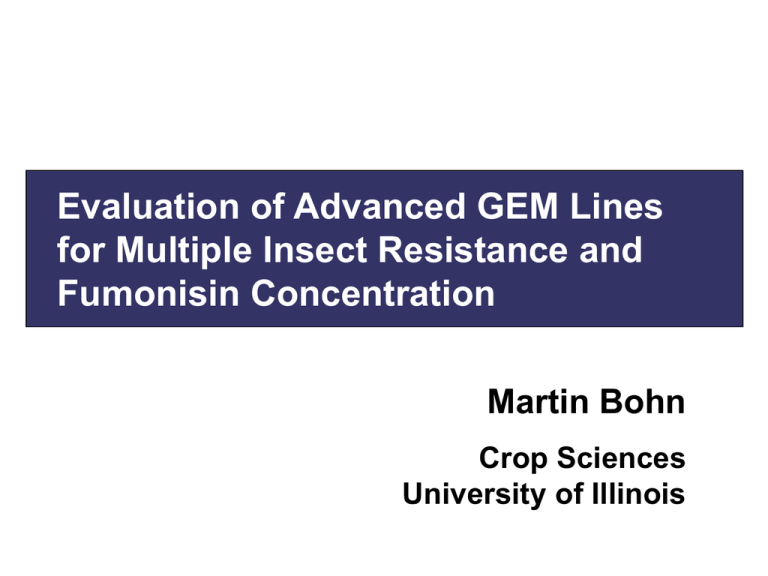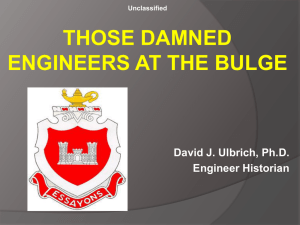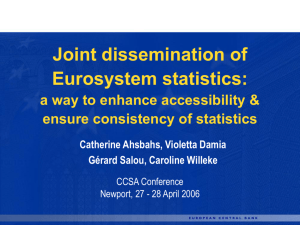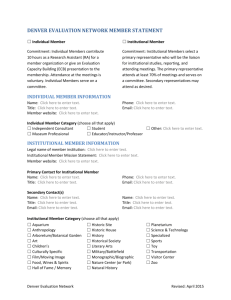Evaluation of Advanced GEM Lines for Multiple Insect Resistance and Fumonisin Concentration
advertisement

Evaluation of Advanced GEM Lines for Multiple Insect Resistance and Fumonisin Concentration Martin Bohn Crop Sciences University of Illinois Objectives Evaluate GEM lines for their resistance against WCR as well as first and second generation ECB. Evaluate GEM lines for their resistance against Fusarium species. Determine the association between insect resistance and fumonisin concentration in GEM germplasm. Objectives Study the genetic basis of insect resistance in maize against both insect species by diallel crosses and testcrosses, and Initiate a recurrent selection program aimed to develop new maize lines with improved multiple insect resistant (MIR). Approach Maize WCR ECB GEM-Pop. (25%) GEM-Pop. (100%) Materials and Methods “Population” “Inbred” 15 Entries 20 Entries Location: Urbana Design: α – lattice, 4 replications Plot size: Population – 4 row plots Inbreds - 2 row plots Row size: 1.50m × 0.75m 10-12 plants hand planted WCR eval.: Trap crop ECB eval.: 1ECB – 180 eggs / plant 2ECB – 180 eggs / plant Materials and Methods: WCR Node-Injury Scale (0.00 – 3.00) (Oleson and Tollefson, Iowa State Uni.) 1.50 No. of full nodes eaten % of a node eaten 0.00 3.00 Materials and Methods: ECB Leaf Damage Rating 1 = no visible leaf feeding 9 = long lesions on most leaves Source: D. Barry Stalk Damage Ratings 1 = no stalk breakage 9 = stalk breakage beneath the ear Number of Larvae Source: T. Magg Results: Populations Root Damage Ratings (0.00 – 3.00) 0.60 MIN 0.88 1.00 MEAN 1.40 MAX 1.74 1.80 DKXL212:N11a01 UR10001:N1708b UR10001:N1702 CH05015:N1204 DKB844:S1612 NGSDCRW1(S2)C4-15-2S2(S1) FS8A(T):N1804 FS8A(S):S0907 CASH:N1410 AR17056:N2025 AR16026:S1719 AR13035:S11b04 AR17056:S1216 UR13085:N0204 AR16026:N1210 LSD(5%) = 0.99 http://www.ent.iastate.edu/pest/rootworm/nodeinjury/nodeinjury.html Results: Inbreds Root Damage Ratings (0.00 – 3.00) MIN 0.50 0.56 MEAN 1.08 1.50 MAX 1.73 2.00 LSD(5%) = 0.74 CUBA117:S1520-153 AR17056:N2025-728 B64 CUBA117:S1520-182 AR17056:N2025-#5 AR17056:N2025-522 CUBA117:S1520-52 CUBA117:S1520-41 CUBA117:S1520-156 AR17056:N2025-546 AR17056:N2025-508 AR17056:N2025-#2 AR17056:N2025-532 B37 Mo17 AR17056:N2025-#4 NGSDCRW1(S2)C4-15 AR17056:N2025-#1 AR17056:N2025-#3 B73 http://www.ent.iastate.edu/pest/rootworm/nodeinjury/nodeinjury.html Results: ECB Evaluation of inbreds derived from GEM populations (25% exotic) for various ECB resistance traits. LDR SDR1 SDR2 1ECB 2ECB Mean SE Min Max 3.97 2.34 3.96 2.51 3.46 0.68 0.82 0.64 0.84 0.78 3.18 1.82 3.04 1.85 2.45 5.25 2.96 5.44 3.52 4.54 SE = Standard error Results: ECB Evaluation of GEM populations (25% exotic) for various ECB resistance traits. LDR SDR1 SDR2 1ECB 2ECB Mean SE Min Max 4.73 4.18 2.90 4.10 3.41 0.23 0.60 0.71 0.46 0.65 2.73 2.38 2.14 2.79 2.33 7.62 6.54 4.50 7.26 5.06 SE = Standard error Summary Results confirm: Populations AR17056:N2025 and CUBA117:S1520 are possible sources of WCR resistance. Four inbreds derived from populations AR17056:N2025 (2) and CUBA117:S1520 (2) showed significantly (P < 0.05) lower root damage ratings than the resistant check. Significant (P < 0.01) differences between entries were found for leaf damage ratings. Some inbreds and populations showed intermediate levels of resistance against the first generation ECB. Differences between entries for stalk damage ratings and number of larvae were not significant. Activities in 2004 Repeat experiment! Screen more GEM germplasm! Conduct diallel study! Initiate recurrent selection programs! Acknowledgements Mike Gray Sue Ratcliffe Kevin Steffey And to the “rest” of crew: Brad Engel Ricardo Fonseca





